I always enjoy the opportunity to do media training with our clients (we call them Members).
Our focus is typically on trying to simulate the toughest interview they will have in their career in the hope that every interview from that point forward will be that much easier.
Outside of showing how to handle a combative host (that’s a blog post for another day), one of the toughest lessons in media training is understanding the fine line between finding appropriate ways to mention your book, product or service on air and over-selling it.
We’ve all heard the interviews where the guest is overly promotional and, as soon as we hear it, we’re on to the next channel.
Have you ever thought of your website the same way?
After all, most visitors land on your website in the same mindset they have when watching or listening to an interview – they want to be informed and entertained – not sold.
Far too many view their website primarily as a sales tool instead of a media property.
There are many reasons why this is the wrong approach but here’s an example of a major one:
Let’s say you are an author and you do an interview on NPR. After that interview, 1,000 people are interested enough in the message to land on your website.
Of those 1,000 people, 1% are so impressed with your interview that they’re ready to buy the book.
Great—10 books sold…but what about the other 990 people who were interested enough to get to the site but aren’t quite ready to make a buying decision?
We know they’re interested in the topic, but because you haven’t given them anything of value (outside of buying something), those 990 are hitting the back button in their browser and will likely never be back again.
However, if you change your mindset and shift from thinking of your website as an online brochure (a sales tool) to thinking of it as a media property, you can focus instead on providing a valuable call to action (either great content or a quiz/assessment) that feel completely free to the site visitor but which is actually the first step in what could be a long and lucrative relationship for you both. When you do this, you’ve extended your interaction with the much larger percentage of people who aren’t yet ready to buy and, in doing so, have given yourself not only the long-term leverage of a growing email list but also the opportunity to nurture that lead over time and turn them into a bigger customer.
So, how do you make this shift and shock your website back to life? Here are four questions to ask yourself:
1. Be honest – does your website more closely resemble a media property or a brochure?
95% of the websites I see for authors, experts and businesses are essentially online brochures. Such websites typically offer 5-10 pages of static information, including bios, accolades, contact and location information.
This kind of website achieves three goals:
- It makes a first impression
- It provides facts (location, background, bios, etc)
- It can convert a sale if someone is ready to buy
The call to action on a brochure website is typically one of two things:
- Click here to buy our widget
- Click here/call this number to schedule an appointment
Again, this kind of website converts the small percentage of people who are ready to make a buying decision that day but it dramatically limits the effectiveness of advertising, marketing and PR efforts because it is set up only for the people who are ready to take a significant step with you that day.
It’s a dead end website. If you have a website like this, you are spinning your wheels – wasting time, money and an opportunity to build long-term leverage.
2. Are you set up for the 1%, the 99% or the 100%?
As mentioned in the previous question, it’s important to think about what you’re offering to visitors once they land on your website.
You are either set up for the:
- 1% = Your call to action is limited to either “buy now” or “call to set up your appointment”
- 99% = Your call to action is focused on the vast majority of website visitors who aren’t yet ready to buy, but who are interested in your topic area. This might include a chance to join an email newsletter, offering a free download or, even better, a quiz or assessment.
- 100% = Your website is set up to capture both those looking to buy now and those who aren’t yet ready to buy but can be nurtured over time with a smart content marketing strategy
Make sure your site works for the 100%!
One great way to set yourself up for the 100% is to build a quiz or assessment on your site using a service like Catch Engine, the software platform we built to make developing one as easy and cheap as possible. I’m actually in the middle of developing an assessment to make this shift myself.
3. Does your website rock on mobile?
Most people spend all of their time worrying about how the home page of their website looks on a 19 inch iMac screen but the reality is that most people will enter your website via a mobile device, not a large computer.
Most websites built today are responsive (meaning that the design fits to the size of the screen used for viewing) but, to most, the mobile design is a total afterthought.
The other thing to consider is not just how your home page looks but, perhaps more importantly, how your blog looks. If you’re doing it right, your website should lag behind the blog in terms of inbound traffic coming in to your website and its ability to convert a site visitor from initial interest to email subscriber is a major step in building a platform.
Take a look at your blog via your smart phone and ask yourself whether or not it’s set up for success.
4. Does your website reflect the most current version of your brand?
As those who have done it before know, building a website is a very hard thing to do – even when you’ve hired someone to do it for you! You have to review designs, write the content, review the full page mocks and write more content.
When the new website finally launches, most people don’t want to think about updating again for years to come based on the hassle factor.
I totally understand that feeling but your website should be a living, breathing extension of your brand.
How many media properties do you pay attention to that never get updated?
In additional to blogging regularly, it’s important to constantly be looking at your website to make sure it is fully updated and the most current reflection of your brand (the same goes for LinkedIn, by the way).
Make sure your press room stays updated with the most recent media hits, your bio reflects the latest developments in your career and the overall brand positioning is consistent with what you want to be known for.
Get into the habit of consistently going to your website and asking yourself if it reflects the most current version of your brand.
Don’t let your website become a dead end – ask these four questions and take action to go to the next step with your platform.




